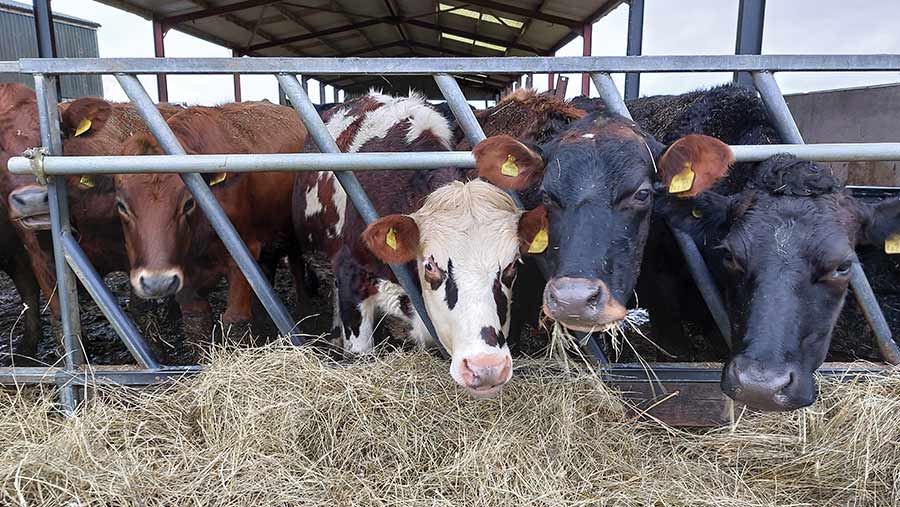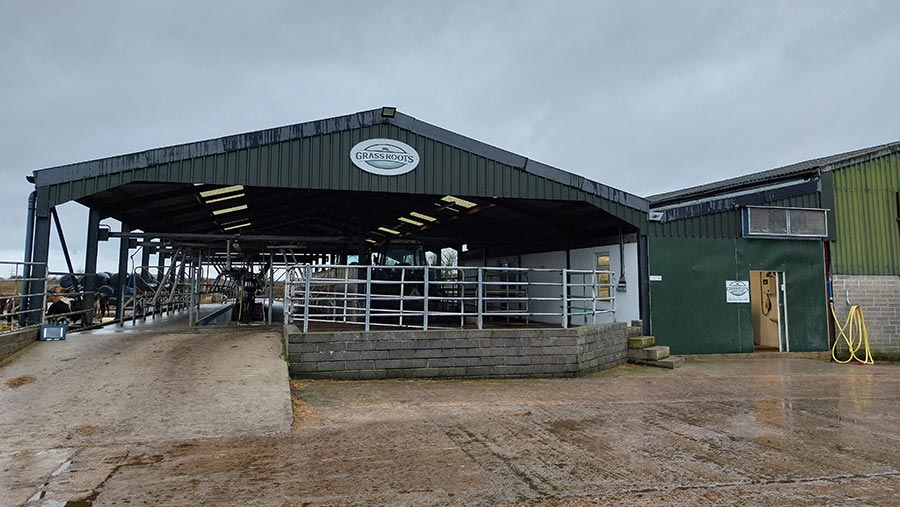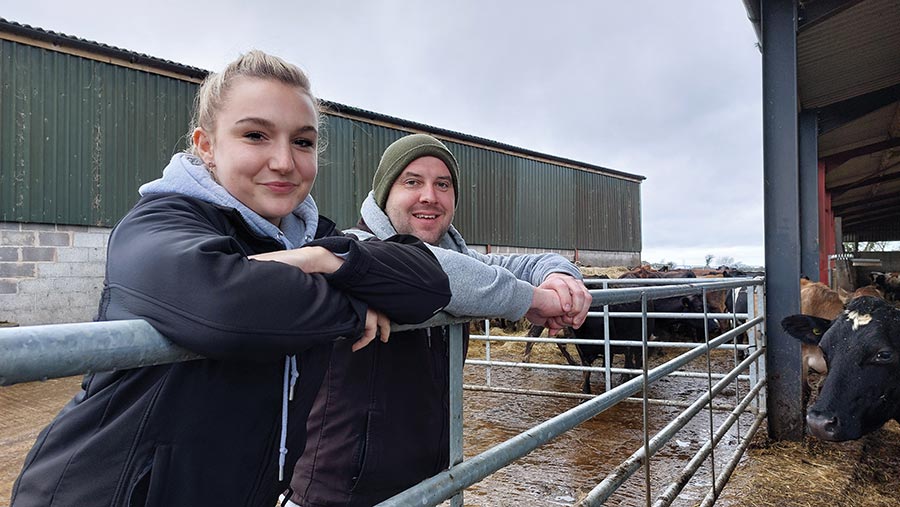How a new entrant got backing to set up in dairy
 © MAG/Shirley MacMillan
© MAG/Shirley MacMillan A simple, once-a-day system, relying on grazed grass and spring-block calving, was the step into dairy farming for new entrant Nick Cavill.
The first cups went on in 2018 and he now has just two years left until the end of his £40,000 loan repayment to the Let’s Farm Foundation.
Having done his research, and with £150,000 available, Nick realised this system was his only financially viable way into milking cows, having reared heifers for other farmers and set up a contracting business – as reported in Farmers Weekly in 2018.
See also: How a new entrant has set up his own dairy after 17 years of hard work
He believes his setup combines profitability with a good lifestyle. “I’ve got happy cows, excellent fertility – we have a 95% conception rate – no lameness or metabolic disease, and just 3% mastitis,” he says.
Nick now rents 162ha (400 acres) from five different landlords, the majority on annual agreements.
He was able to get a 12-year farm business tenancy on the 57ha (140-acre) home farm, which helped with raising capital for erecting new buildings.
Loan options
Without security, however, his initial business plan only included an £80,000 loan from the bank.
There were plenty of finance options, he says, just the terms were very hard to meet.
He could have borrowed £100,000 as an unsecured loan, but the interest rate was 7-8% and payback was within 12 months.
“So, payments would have been unaffordable. The [foundation] loan was enough to get going – though it was horribly tight,” he says.
Farm facts
Grass Roots Dairy, Godney, Somerset
- 150 Jersey-cross cows
- 60 heifers a year
- Spring-block calving
- Organic, selling to Arla McDonald’s
- Once-a-day milking
- No bought-in feed
- Farming 162ha: 57ha dairy platform; 42ha silage plus youngstock; 73ha silage plus youngstock within three miles
- Peat soils
- Calving in six weeks from 10 February
- Average 3,000 litres at 5.3% fat and 4.1% protein
The charity loan was at 4.5% above base, with repayments spread over eight years.
Nick says it had more requirements for budgets, plans and cashflows than any other lender, plus quarterly reviews.
However, he accepted the importance of regular budgeting and says he has continued the monthly discipline because it is essential to the business.
Investment in infrastructure
The money was spent on milking infrastructure, including a 10-year-old 20/40 Waikato parlour and bulk tank for £10,000, a simple roof over concrete for the open-sided parlour shed, and a handling race for 20 animals.
“The collecting yard was made with scaffolding sides and can hold 240 animals weighing 450kg each; there is no feeding in parlour and no backing gate.”

© MAG/Shirley MacMillan
Two loose yards were erected for winter housing, and, despite the cost of straw, Nick says it meant he did not have the expense of installing a slurry handling system.
“We compost the muck ourselves over two years and it is our fertiliser,” he says, adding that, usually, the herd outwinters on deferred grazing and bales.
The farm made money from its first trading year, which freed Nick to change banks and secure a further £36,000 loan. “This allowed me to pay off some creditors,” he says.
A further £18,000 on an overdraft basis, plus a deal to lease back the parlour, assisted his business. And cashflow was helped by extending credit terms with his long-term suppliers, in the contracting enterprise, for 18 months.
“It wasn’t good business, and it was stressful, so I can’t advocate it to anyone else. It got us there,” he admits.
Planning and budgeting
Running a simple system means that Nick knows his costs inside out. However, rocketing energy costs have led to £30,000 being invested in solar panels, with milking moved to 9.30am each day to run on solar power.
His advice to other new entrants is to budget and not overstretch borrowings.
He also recommends visiting other farms and plenty of discussion about plans before committing. “In this industry, 99% of people want to help. Take time to plan and research it thoroughly.”

Nick Cavill (right) with Morgan Elms © MAG/Shirley MacMillan
Original plans to grow the herd to 195 cows have changed as Nick learns more about the farm and business.
“I’m not worried about owning land anymore; rather, I’d like to build assets and buy rental properties.
“To expand the business, I’d like to adapt the system, and I’m looking at the potential for a mobile milking system on land off-farm.”
Loan scheme for dairy entrants
Let’s Farm Foundation (formerly Dairy Futures) is offering to help people with the determination and ability to succeed to build their own sustainable dairy farm.
The charity and its wholly owned loan company were set up by an anonymous benefactor 10 years ago to provide unsecured loans, says chief executive Becky Miles.
“We also offer help and support for new entrants to improve their skill sets, put a business plan together, and find a milk contract.
“We effectively give them a leg up in their career by plugging the financial gap to get them off the ground with a loan of up to £100,000,” she says.
“We have a group of experienced trustees representing all dairy farm systems, who have fantastic expertise on offer.
“If an applicant is successful, we marry them up with a trustee as a mentor for as long as they want.”
Business skills
Becky finds the biggest hurdle for aspiring dairy farmers is their lack of business skills.
Though very competent technically (they can manage cows, budget feed and grassland), most do not seem to understand cashflows and budgets.
“And they only realise this when they apply for a tenancy, then a business loan at short notice,” she adds.
The foundation can steer people on the right course and teach them appropriate know-how. Help is also available to network and build contacts in the industry.
“People need to know that you are looking,” Becky points out.
Loan applications are welcome UK-wide and there is no age barrier: “It’s all about attitude and mindset, and having a sensible business plan.
“The loans are unsecured, but everyone applying must have built up some assets through their own efforts, such as cows or machinery. They also need to have some borrowing from a commercial lender,” she explains.
Repayment terms and conditions are calculated at the point of borrowing; Becky says rates are commercial and favourable compared with the marketplace.
So far, the charity has helped new entrants to start dairy farming with 50 cows, build a housed herd on target for 1,000 cows, milk using robots, and enter into a 200-cow joint venture.
Let’s Farm Foundation – the details
- New entrant criteria: does not own more than 20ha; is not receiving financial support from family or friends; and has not been farming for more than 10 years
- Loans finance breeding stock, parlours, sheds, feed/slurry storage – not machinery or vehicles
- The loan is made as a lump sum with monthly repayments
- Maximum 10-year term
- No financial help for diversifications or added-value enterprises
- Find more information, including how to apply, at letsfarmfoundation.org
